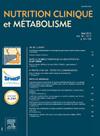Qualité de l’alimentation, activité physique et image corporelle d’adultes actifs : comparaison selon le rythme de travail (régulier jour/travail posté)
IF 0.4
4区 医学
Q4 ENDOCRINOLOGY & METABOLISM
引用次数: 0
Abstract
Objectives
A healthy diet, regular physical activity and a positive body image are essential elements to maintain the physical and mental health of employees. The objective was to describe these aspects in workers, comparing those working during the day with those with cyclical work.
Materials and methods
Cross-sectional study by questionnaire divided into two groups according to the work rhythm: 140 day workers (DW) and 106 shift workers (SW). The data collected concerned their diet, physical activity, body image and anthropometric measurements.
Results
The study involved 246 men (age: 35.0 ± 8.1 years old). Smoking was dominant (89.8%; P = 0.0000). The average daily energy intake was 1861.2 ± 800.9 kcal/day (60.3% carbohydrates, 16.9% proteins, 22.6% lipids), with no difference between the two groups (P = 0.3671). The mean score of the Diet Quality Index-International (DQI-I) was 56.2 ± 9.3 points, with no difference between DW and SW (P = 0.1439). Non-athletes were predominant (55.3%; P = 0.0190). Employees spent 2.1 ± 1.4 hours/day in a sedentary position outside of work and DWs slept more (P = 0.0381). Excess weight was present in 54.1%. Among the employees, 31.7% had an erroneous perception of their body weight (under or overestimation). Body dissatisfaction concerned 59.8%.
Conclusion
SWs seemed to have similar aspects to DWs. Workers’ health is a global issue that requires interventions by occupational medicine, adapted to their specific needs, and beneficial for both individuals and the company.
积极成年人的饮食质量、身体活动和身体形象:按工作节奏比较(每天定期工作/张贴工作)
目的健康的饮食、规律的体育锻炼和良好的身体形象是保持员工身心健康的基本要素。目的是描述工人的这些方面,比较那些白天工作的人和那些周期性工作的人。材料与方法采用问卷调查法进行横断面研究,根据工作节奏分为两组:140名白班工人(DW)和106名轮班工人(SW)。收集的数据涉及他们的饮食、身体活动、身体形象和人体测量值。结果共纳入246例男性(年龄:35.0±8.1岁)。吸烟占主导地位(89.8%;p = 0.0000)。平均日能量摄入为1861.2±800.9 kcal/d(碳水化合物60.3%,蛋白质16.9%,脂类22.6%),两组间差异无统计学意义(P = 0.3671)。饮食质量指数-国际(DQI-I)的平均得分为56.2±9.3分,DW与SW之间无差异(P = 0.1439)。非运动员居多(55.3%);p = 0.0190)。员工在工作之外每天坐着的时间为2.1±1.4小时,dw的睡眠时间更长(P = 0.0381)。54.1%的人体重超标。31.7%的员工对自己的体重有错误的认知(低估或高估)。对身体不满意的占59.8%。结论sws与DWs有相似之处。工人健康是一个全球性问题,需要通过职业医学进行干预,适应他们的具体需要,对个人和公司都有利。
本文章由计算机程序翻译,如有差异,请以英文原文为准。
求助全文
约1分钟内获得全文
求助全文
来源期刊

Nutrition Clinique et Metabolisme
医学-内分泌学与代谢
CiteScore
0.80
自引率
16.70%
发文量
216
审稿时长
78 days
期刊介绍:
Nutrition Clinique et Métabolisme is the journal of the French-speaking Society of Enteral and Parenteral Nutrition. Associating clinicians, biologists, pharmacists, and fundamentalists, the articles presented in the journal concern man and animals, and deal with organs and cells. The goal is a better understanding of the effects of artificial nutrition and human metabolism. Original articles, general reviews, update articles, technical notes and communications are published, as well as editorials and case reports.
 求助内容:
求助内容: 应助结果提醒方式:
应助结果提醒方式:


